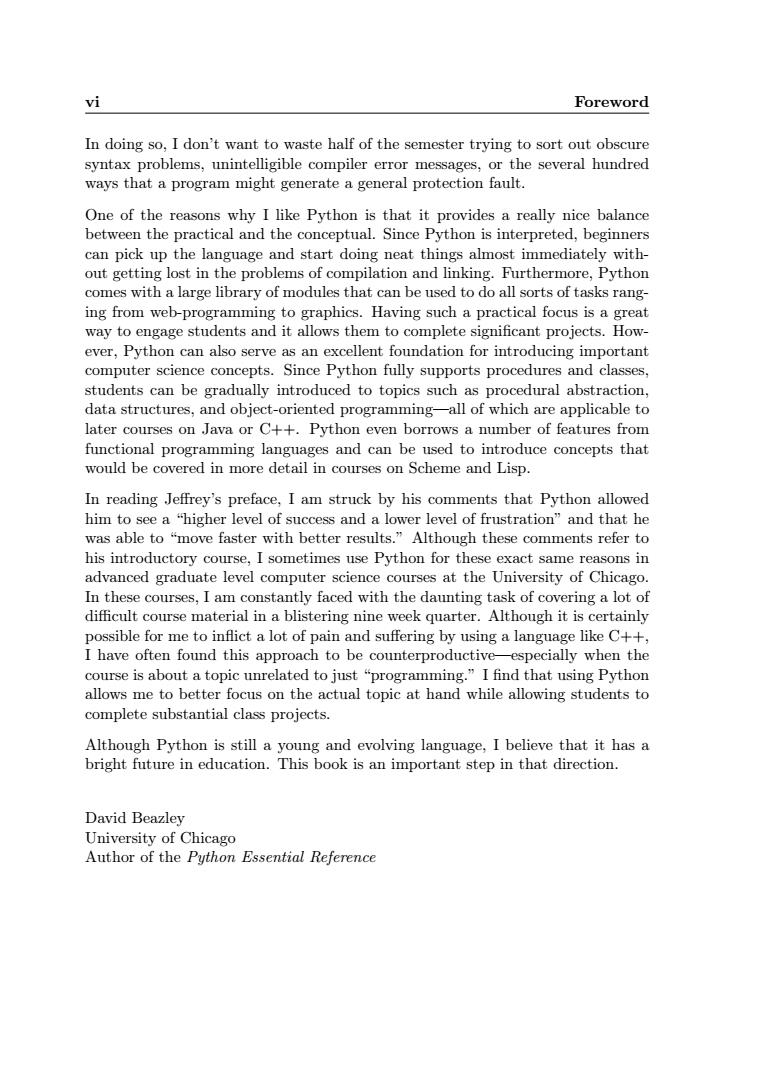正在加载图片...

vi Foreword In doing so,I don't want to waste half of the semester trying to sort out obscure syntax problems,unintelligible compiler error messages,or the several hundred ways that a program might generate a general protection fault. One of the reasons why I like Python is that it provides a really nice balance between the practical and the conceptual.Since Python is interpreted,beginners can pick up the language and start doing neat things almost immediately with- out getting lost in the problems of compilation and linking.Furthermore,Python comes with a large library of modules that can be used to do all sorts of tasks rang- ing from web-programming to graphics.Having such a practical focus is a great way to engage students and it allows them to complete significant projects.How- ever,Python can also serve as an excellent foundation for introducing important computer science concepts.Since Python fully supports procedures and classes, students can be gradually introduced to topics such as procedural abstraction, data structures,and object-oriented programming-all of which are applicable to later courses on Java or C++.Python even borrows a number of features from functional programming languages and can be used to introduce concepts that would be covered in more detail in courses on Scheme and Lisp. In reading Jeffrey's preface,I am struck by his comments that Python allowed him to see a "higher level of success and a lower level of frustration"and that he was able to "move faster with better results."Although these comments refer to his introductory course,I sometimes use Python for these exact same reasons in advanced graduate level computer science courses at the University of Chicago. In these courses,I am constantly faced with the daunting task of covering a lot of difficult course material in a blistering nine week quarter.Although it is certainly possible for me to inflict a lot of pain and suffering by using a language like C++, I have often found this approach to be counterproductive-especially when the course is about a topic unrelated to just "programming."I find that using Python allows me to better focus on the actual topic at hand while allowing students to complete substantial class projects. Although Python is still a young and evolving language,I believe that it has a bright future in education.This book is an important step in that direction. David Beazley University of Chicago Author of the Python Essential Referencevi Foreword In doing so, I don’t want to waste half of the semester trying to sort out obscure syntax problems, unintelligible compiler error messages, or the several hundred ways that a program might generate a general protection fault. One of the reasons why I like Python is that it provides a really nice balance between the practical and the conceptual. Since Python is interpreted, beginners can pick up the language and start doing neat things almost immediately without getting lost in the problems of compilation and linking. Furthermore, Python comes with a large library of modules that can be used to do all sorts of tasks ranging from web-programming to graphics. Having such a practical focus is a great way to engage students and it allows them to complete significant projects. However, Python can also serve as an excellent foundation for introducing important computer science concepts. Since Python fully supports procedures and classes, students can be gradually introduced to topics such as procedural abstraction, data structures, and object-oriented programming—all of which are applicable to later courses on Java or C++. Python even borrows a number of features from functional programming languages and can be used to introduce concepts that would be covered in more detail in courses on Scheme and Lisp. In reading Jeffrey’s preface, I am struck by his comments that Python allowed him to see a “higher level of success and a lower level of frustration” and that he was able to “move faster with better results.” Although these comments refer to his introductory course, I sometimes use Python for these exact same reasons in advanced graduate level computer science courses at the University of Chicago. In these courses, I am constantly faced with the daunting task of covering a lot of difficult course material in a blistering nine week quarter. Although it is certainly possible for me to inflict a lot of pain and suffering by using a language like C++, I have often found this approach to be counterproductive—especially when the course is about a topic unrelated to just “programming.” I find that using Python allows me to better focus on the actual topic at hand while allowing students to complete substantial class projects. Although Python is still a young and evolving language, I believe that it has a bright future in education. This book is an important step in that direction. David Beazley University of Chicago Author of the Python Essential Reference